Abstract
1. We assessed the effects of specific brain hypoxia on the control of inspiratory and expiratory muscle electromyographic (EMG) activities in response to specific carotid body hypoxia in seven awake goats. We used an isolated carotid body perfusion technique that permitted specific, physiological, steady-state stimulation of the carotid bodies or maintenance of normoxia and normocapnia at the carotid bodies while varying the level of systemic, and therefore, brain oxygenation. 2. Isolated brain normocapnic hypoxia of up to 1.5 h duration increased inspired minute ventilation (VI) by means of increases in both tidal volume (VT) and respiratory frequency (fR). Electromyographic activities of both inspiratory and expiratory muscles were augmented as well. These responses were similar to those produced by low levels of whole-body normoxic hypercapnia. We conclude that moderate levels of brain hypoxia (Pa,O2 approximately 40 mmHg) in awake goats caused a net stimulation of ventilatory motor output. 3. Hypoxic stimulation of the carotid bodies alone caused comparable increases in VT and fR, and EMG augmentation of both inspiratory and expiratory muscles whether the brain was hypoxic or normoxic. These responses were quite similar to those obtained over a wide range of whole-body normoxic hypercapnia. We conclude that the integration of carotid body afferent information is not affected by moderate brain hypoxia in awake goats. 4. We found no evidence for an asymmetrical recruitment pattern of inspiratory vs. expiratory muscles in response to carotid body hypoxia or in response to brain hypoxia alone. 5. Our data support the concept that moderate brain hypoxia results in a net stimulation of respiratory motor output. These findings question the significance of 'central hypoxic depression' to the regulation of breathing under physiological levels of hypoxaemia in the awake animal.
Full text
PDF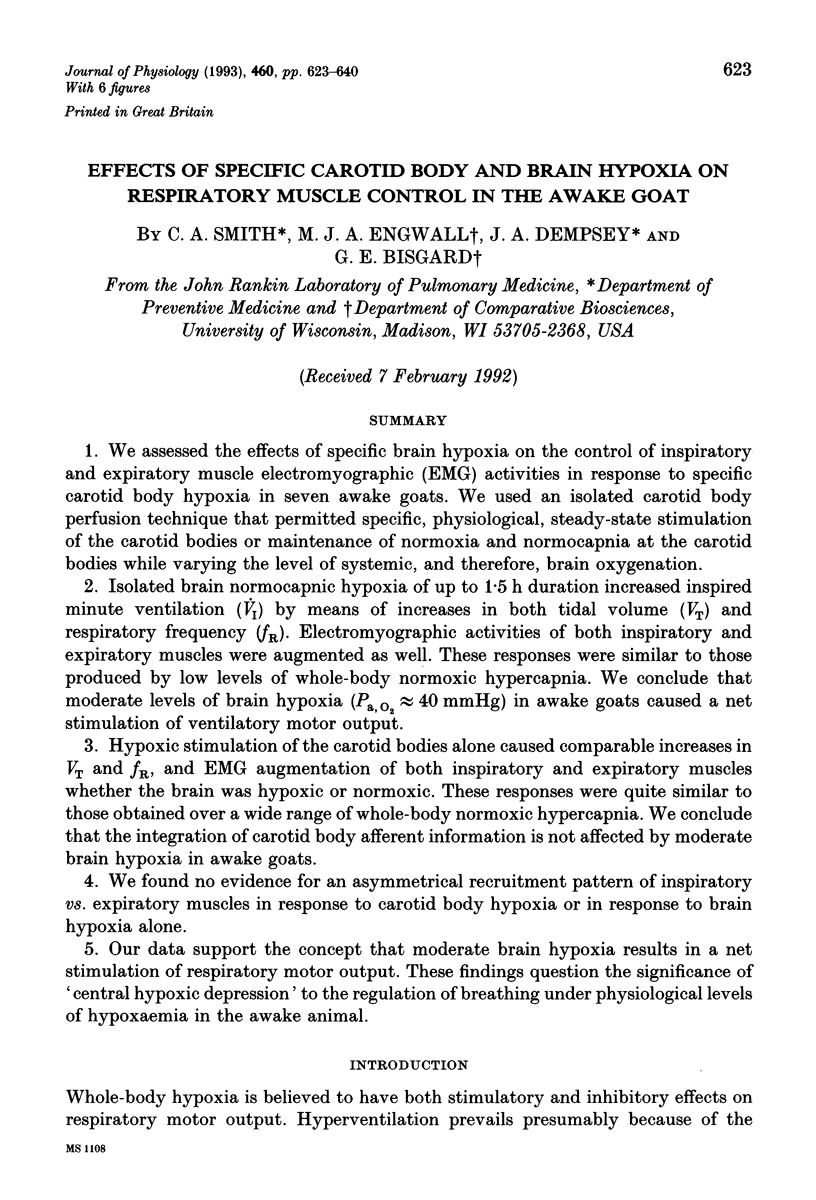

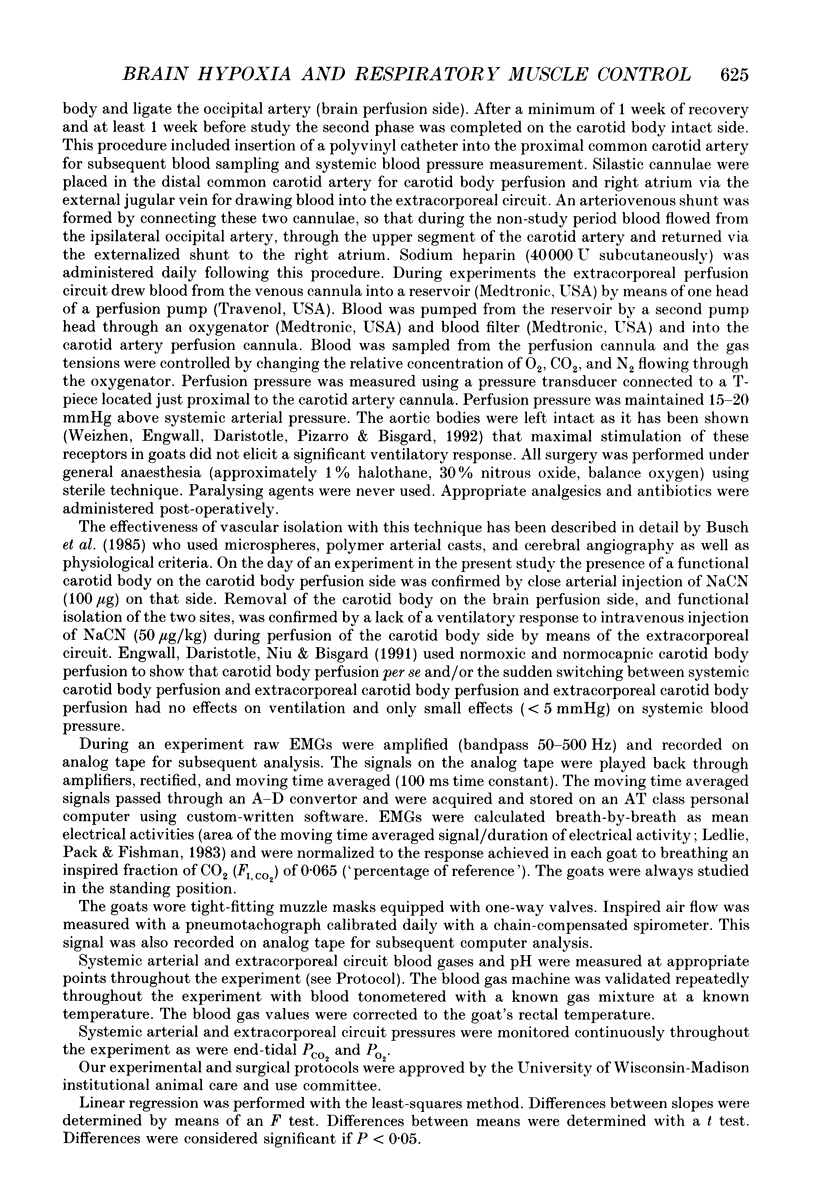
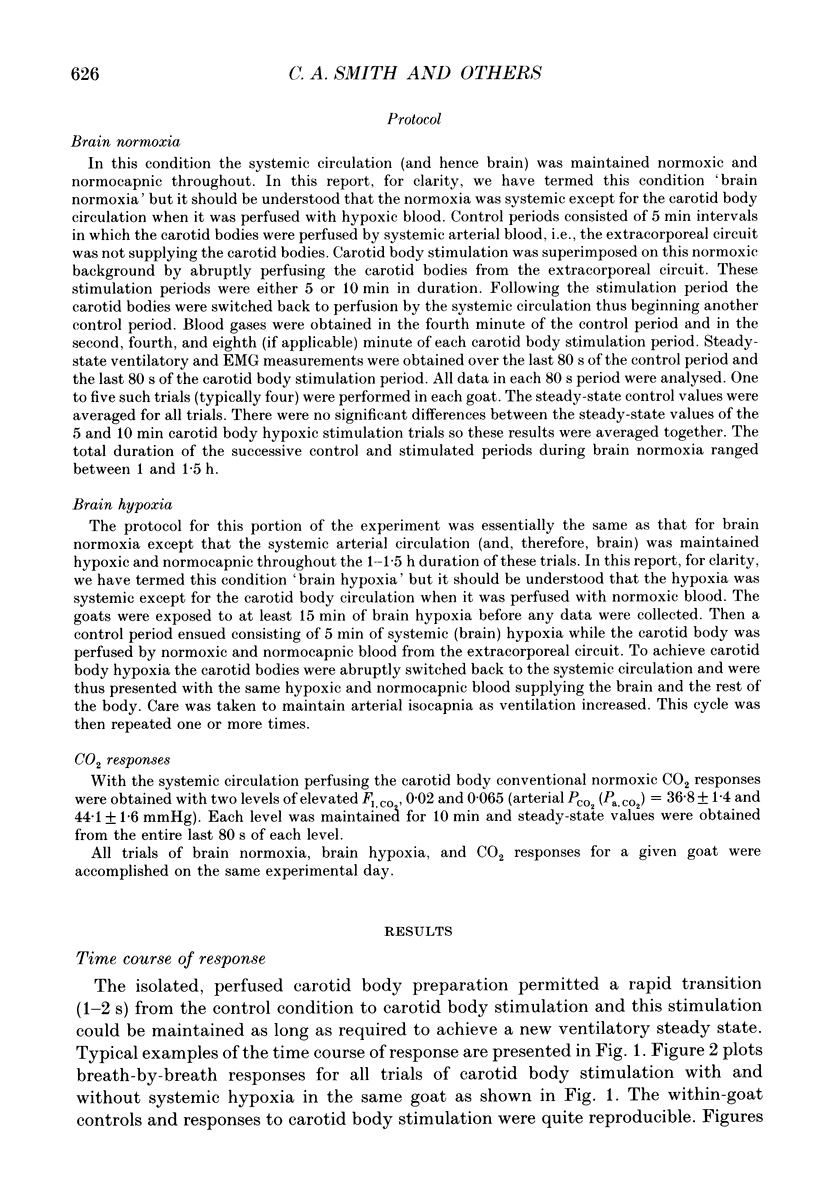
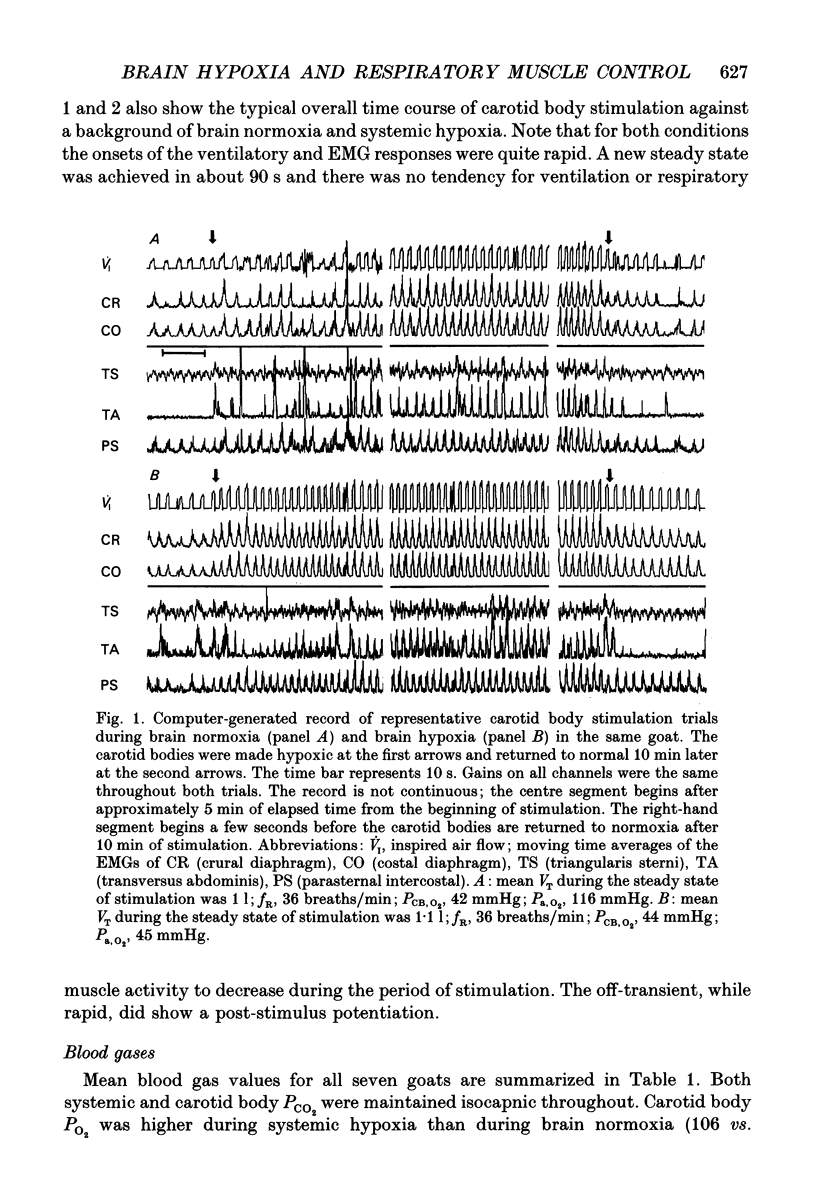
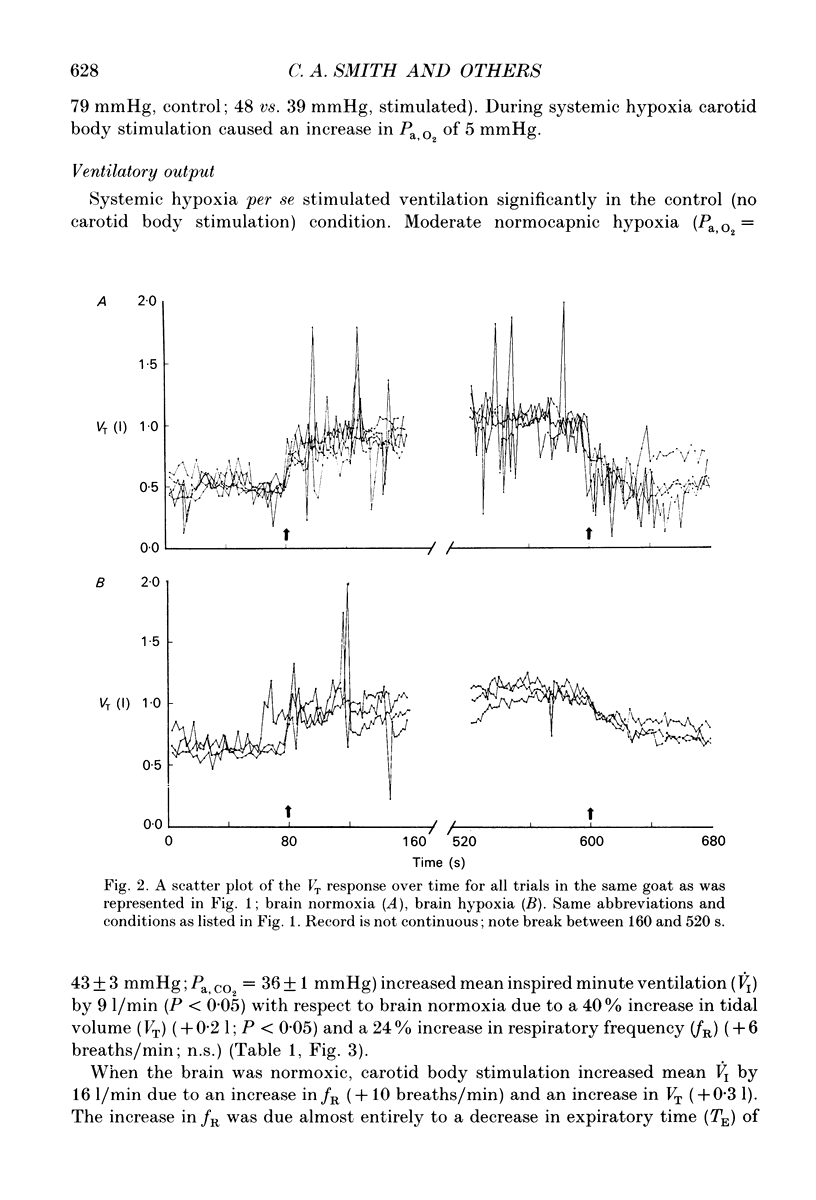
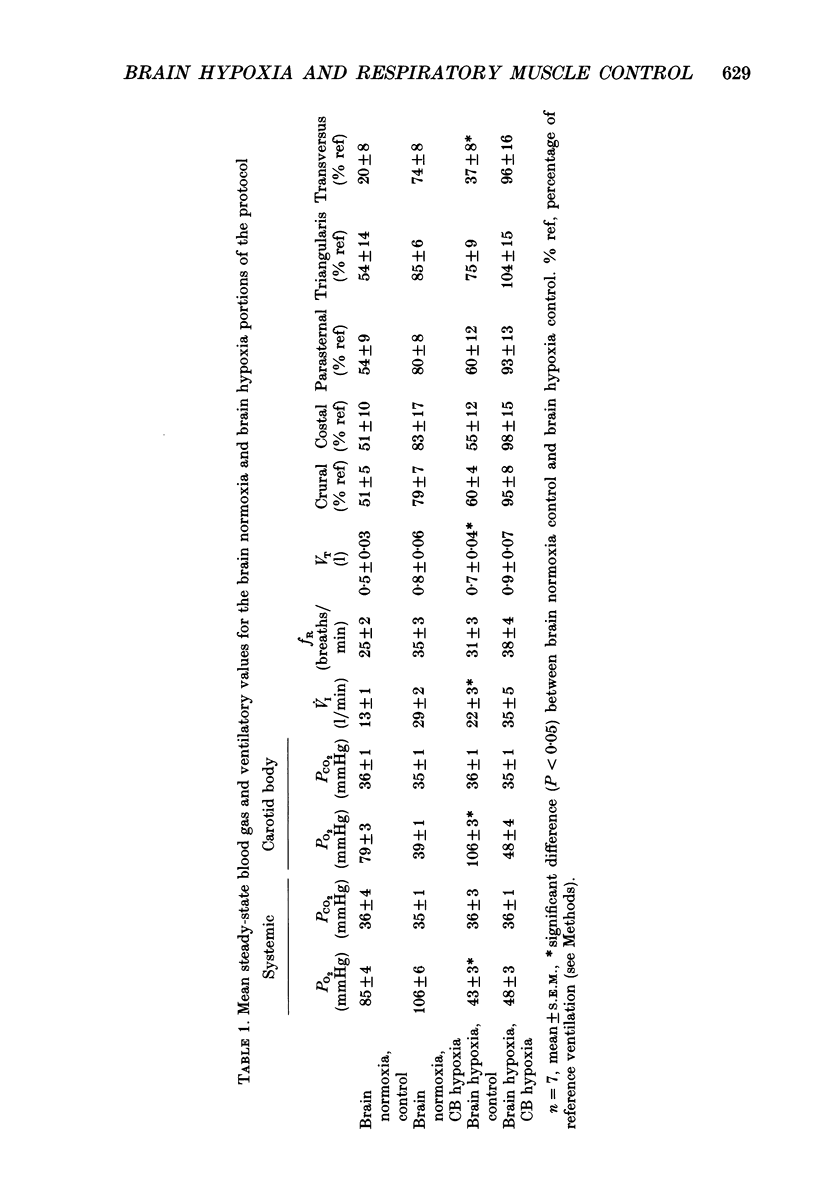
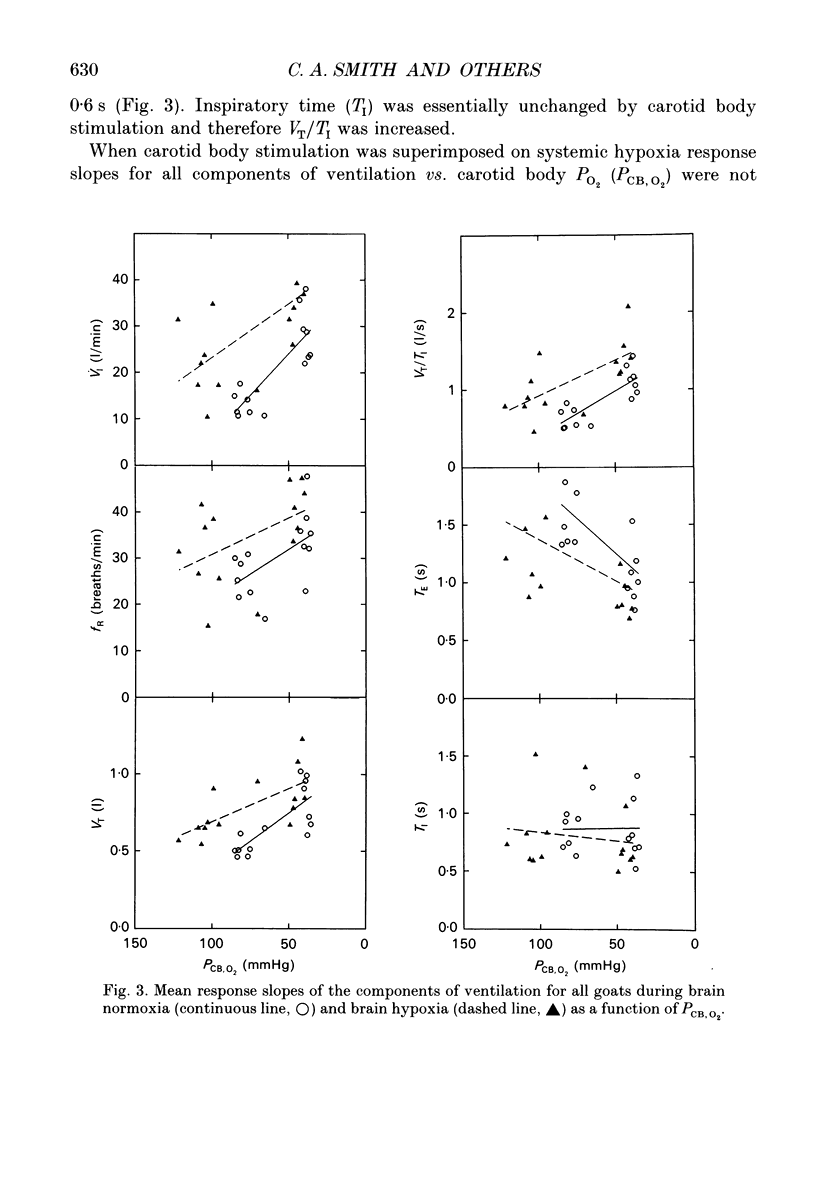
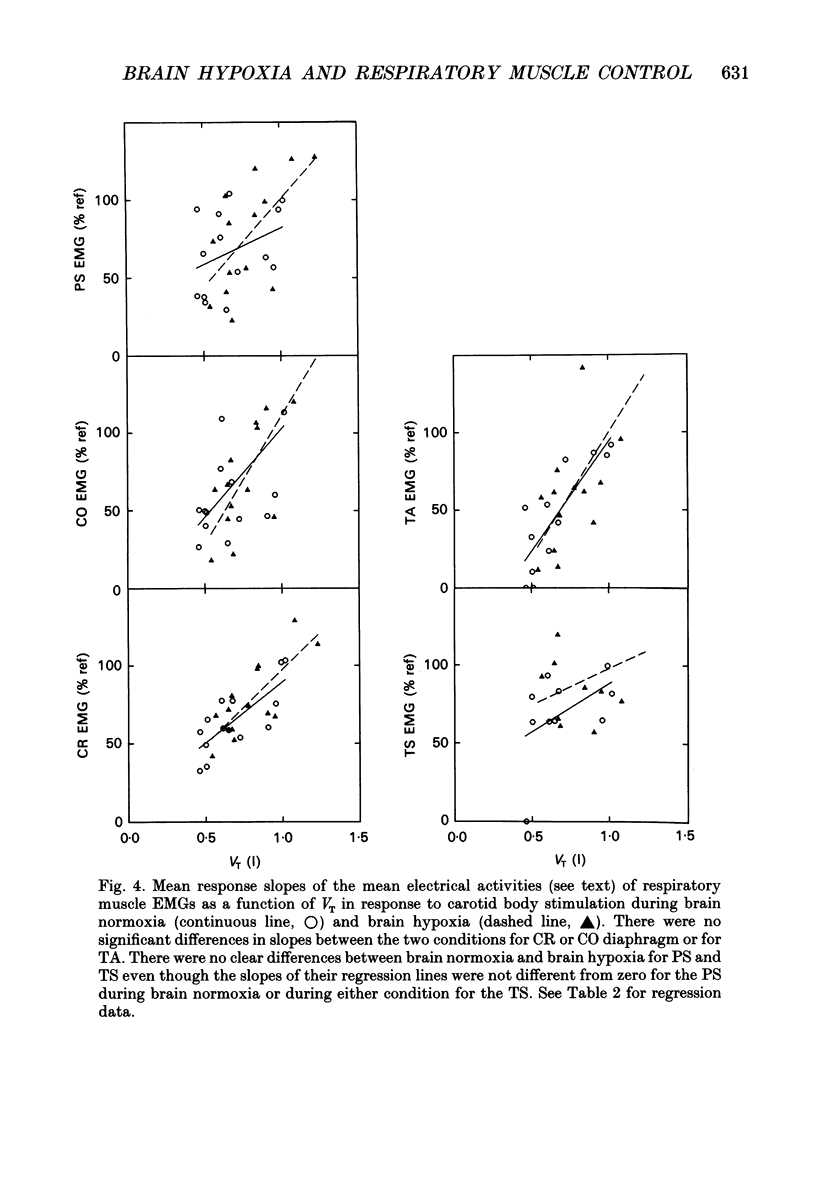
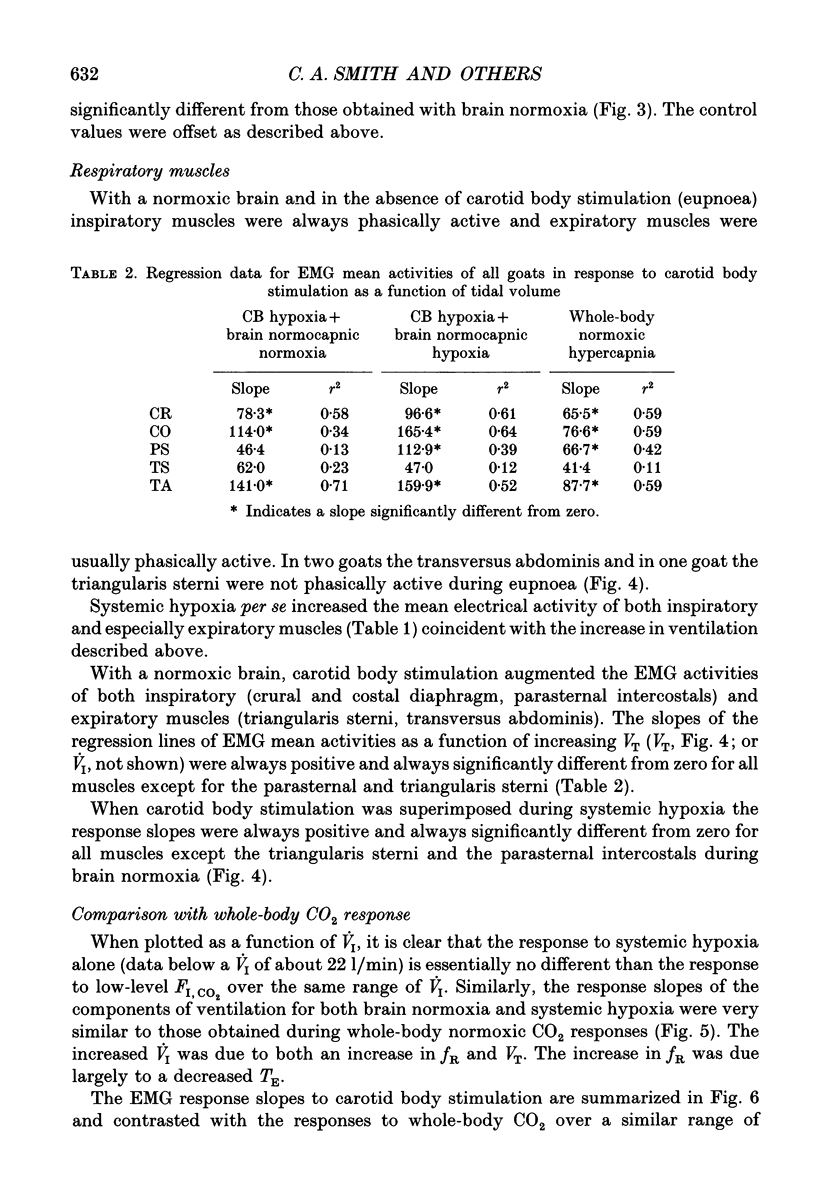

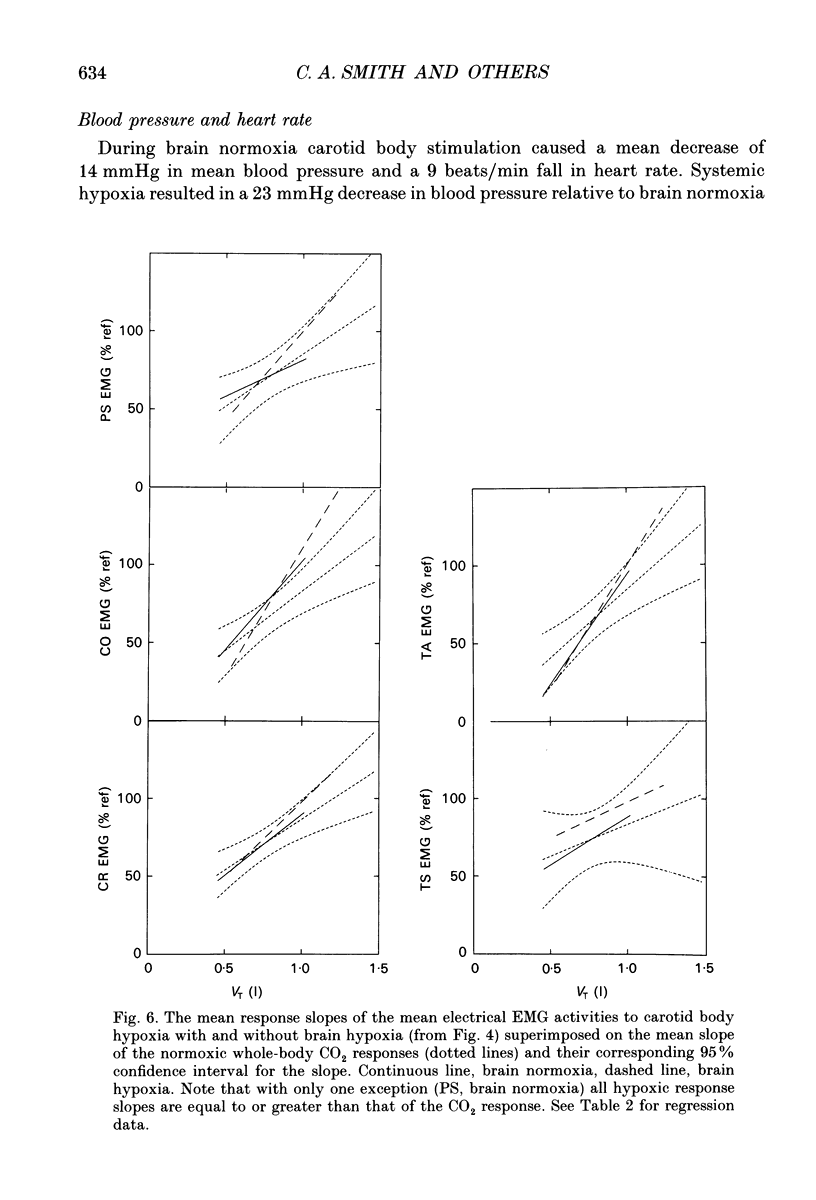

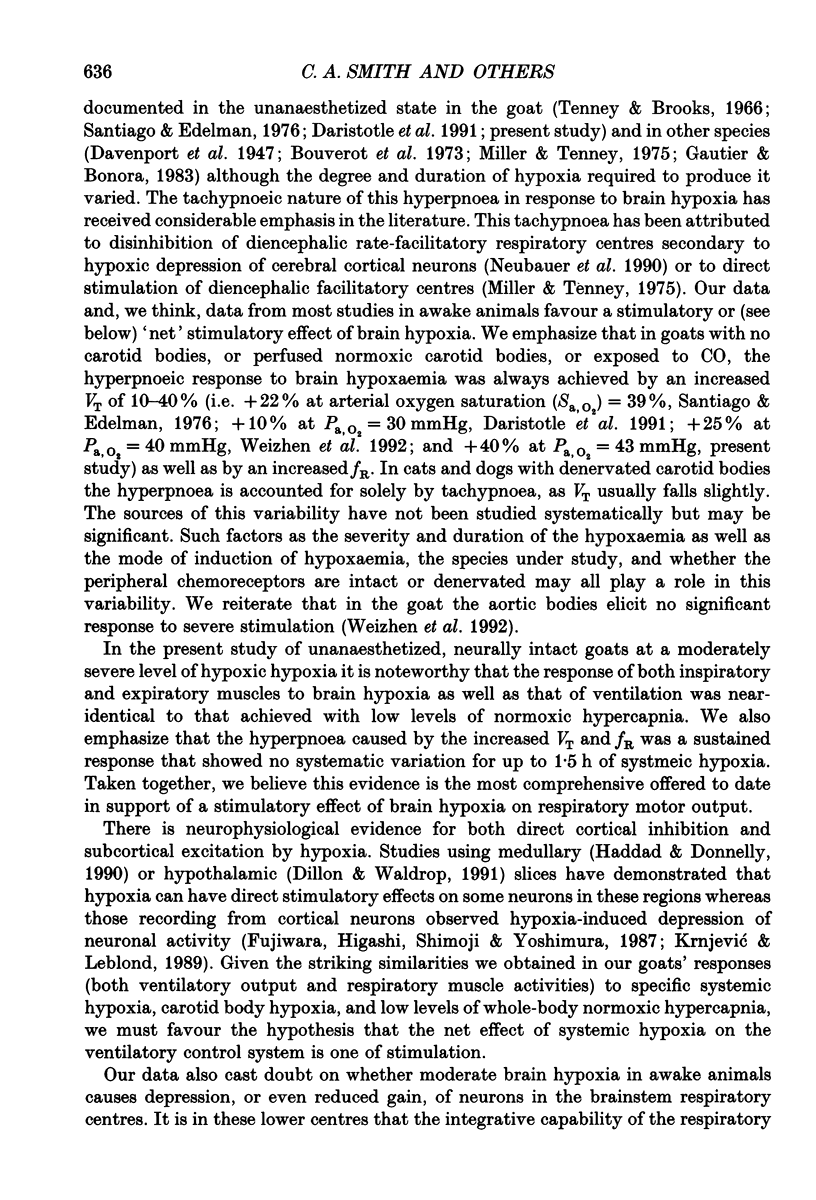



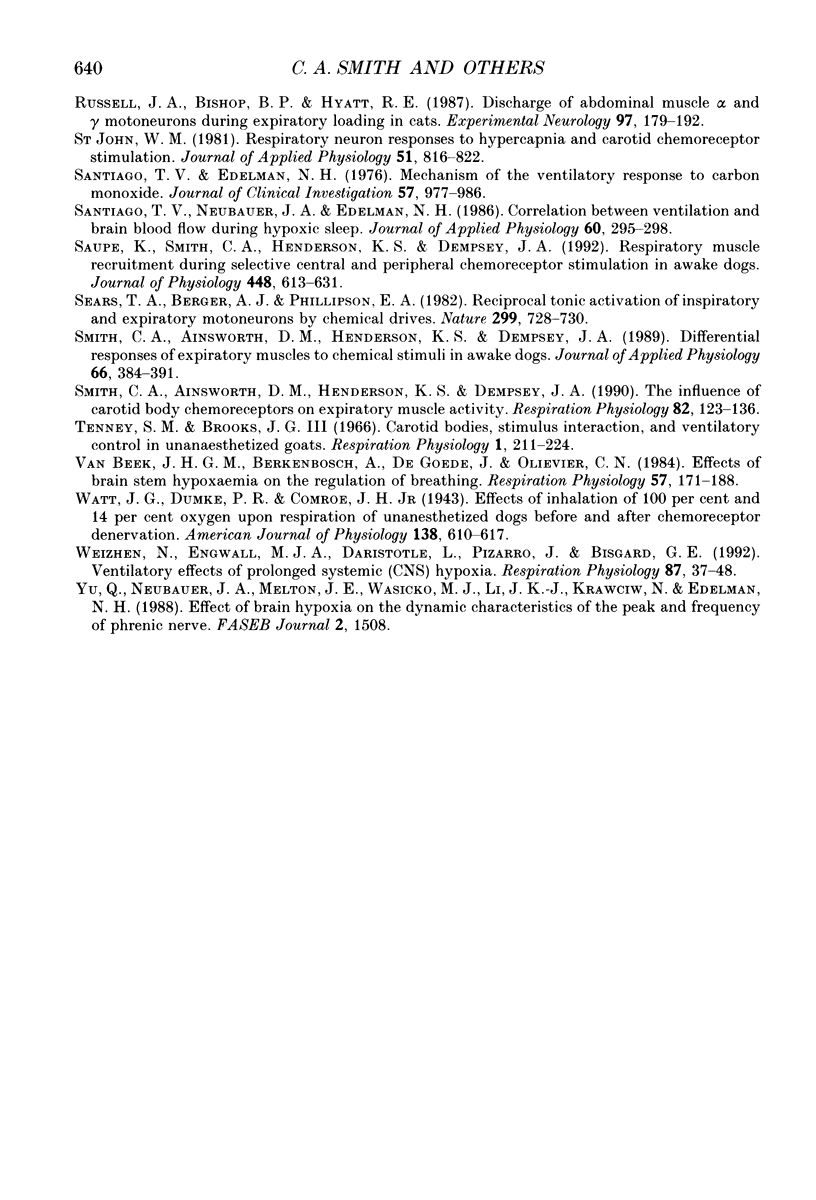
Selected References
These references are in PubMed. This may not be the complete list of references from this article.
- Ainsworth D. M., Smith C. A., Johnson B. D., Eicker S. W., Henderson K. S., Dempsey J. A. Vagal contributions to respiratory muscle activity during eupnea in the awake dog. J Appl Physiol (1985) 1992 Apr;72(4):1355–1361. doi: 10.1152/jappl.1992.72.4.1355. [DOI] [PubMed] [Google Scholar]
- Ainsworth D. M., Smith C. A., Johnson B. D., Eicker S. W., Henderson K. S., Dempsey J. A. Vagal modulation of respiratory muscle activity in awake dogs during exercise and hypercapnia. J Appl Physiol (1985) 1992 Apr;72(4):1362–1367. doi: 10.1152/jappl.1992.72.4.1362. [DOI] [PubMed] [Google Scholar]
- BISHOP B. REFLEX CONTROL OF ABDOMINAL MUSCLES DURING POSITIVE-PRESSURE BREATHING. J Appl Physiol. 1964 Mar;19:224–232. doi: 10.1152/jappl.1964.19.2.224. [DOI] [PubMed] [Google Scholar]
- Bouverot P., Candas V., Libert J. P. Role of the arterial chemoreceptors in ventilatory adaptation to hypoxia of awake dogs and rabbits. Respir Physiol. 1973 Mar;17(2):209–219. doi: 10.1016/0034-5687(73)90062-5. [DOI] [PubMed] [Google Scholar]
- Busch M. A., Bisgard G. E., Forster H. V. Ventilatory acclimatization to hypoxia is not dependent on arterial hypoxemia. J Appl Physiol (1985) 1985 Jun;58(6):1874–1880. doi: 10.1152/jappl.1985.58.6.1874. [DOI] [PubMed] [Google Scholar]
- Daristotle L., Engwall M. J., Niu W. Z., Bisgard G. E. Ventilatory effects and interactions with change in PaO2 in awake goats. J Appl Physiol (1985) 1991 Oct;71(4):1254–1260. doi: 10.1152/jappl.1991.71.4.1254. [DOI] [PubMed] [Google Scholar]
- Farkas G. A., Baer R. E., Estenne M., De Troyer A. Mechanical role of expiratory muscles during breathing in upright dogs. J Appl Physiol (1985) 1988 Mar;64(3):1060–1067. doi: 10.1152/jappl.1988.64.3.1060. [DOI] [PubMed] [Google Scholar]
- Fujiwara N., Higashi H., Shimoji K., Yoshimura M. Effects of hypoxia on rat hippocampal neurones in vitro. J Physiol. 1987 Mar;384:131–151. doi: 10.1113/jphysiol.1987.sp016447. [DOI] [PMC free article] [PubMed] [Google Scholar]
- Gautier H., Bonora M. Ventilatory response of intact cats to carbon monoxide hypoxia. J Appl Physiol Respir Environ Exerc Physiol. 1983 Oct;55(4):1064–1071. doi: 10.1152/jappl.1983.55.4.1064. [DOI] [PubMed] [Google Scholar]
- Georgopoulos D., Bshouty Z., Younes M., Anthonisen N. R. Hypoxic exposure and activation of the afterdischarge mechanism in conscious humans. J Appl Physiol (1985) 1990 Sep;69(3):1159–1164. doi: 10.1152/jappl.1990.69.3.1159. [DOI] [PubMed] [Google Scholar]
- Haddad G. G., Donnelly D. F. O2 deprivation induces a major depolarization in brain stem neurons in the adult but not in the neonatal rat. J Physiol. 1990 Oct;429:411–428. doi: 10.1113/jphysiol.1990.sp018265. [DOI] [PMC free article] [PubMed] [Google Scholar]
- Holtby S. G., Berezanski D. J., Anthonisen N. R. Effect of 100% O2 on hypoxic eucapnic ventilation. J Appl Physiol (1985) 1988 Sep;65(3):1157–1162. doi: 10.1152/jappl.1988.65.3.1157. [DOI] [PubMed] [Google Scholar]
- Huang S. Y., Alexander J. K., Grover R. F., Maher J. T., McCullough R. E., McCullough R. G., Moore L. G., Sampson J. B., Weil J. V., Reeves J. T. Hypocapnia and sustained hypoxia blunt ventilation on arrival at high altitude. J Appl Physiol Respir Environ Exerc Physiol. 1984 Mar;56(3):602–606. doi: 10.1152/jappl.1984.56.3.602. [DOI] [PubMed] [Google Scholar]
- Krnjević K., Leblond J. Changes in membrane currents of hippocampal neurons evoked by brief anoxia. J Neurophysiol. 1989 Jul;62(1):15–30. doi: 10.1152/jn.1989.62.1.15. [DOI] [PubMed] [Google Scholar]
- Ledlie J. F., Pack A. I., Fishman A. P. Effects of hypercapnia and hypoxia on abdominal expiratory nerve activity. J Appl Physiol Respir Environ Exerc Physiol. 1983 Nov;55(5):1614–1622. doi: 10.1152/jappl.1983.55.5.1614. [DOI] [PubMed] [Google Scholar]
- Lipski J., Trzebski A., Chodobska J., Kruk P. Effects of carotid chemoreceptor excitation on medullary expiratory neurons in cats. Respir Physiol. 1984 Sep;57(3):279–291. doi: 10.1016/0034-5687(84)90077-x. [DOI] [PubMed] [Google Scholar]
- Melton J. E., Neubauer J. A., Edelman N. H. CO2 sensitivity of cat phrenic neurogram during hypoxic respiratory depression. J Appl Physiol (1985) 1988 Aug;65(2):736–743. doi: 10.1152/jappl.1988.65.2.736. [DOI] [PubMed] [Google Scholar]
- Miller M. J., Tenney S. M. Hypoxia-induced tachypnea in carotid-deafferented cats. Respir Physiol. 1975 Jan;23(1):31–39. doi: 10.1016/0034-5687(75)90069-9. [DOI] [PubMed] [Google Scholar]
- Neubauer J. A., Melton J. E., Edelman N. H. Modulation of respiration during brain hypoxia. J Appl Physiol (1985) 1990 Feb;68(2):441–451. doi: 10.1152/jappl.1990.68.2.441. [DOI] [PubMed] [Google Scholar]
- Remmers J. E., Bartlett D., Jr Reflex control of expiratory airflow and duration. J Appl Physiol Respir Environ Exerc Physiol. 1977 Jan;42(1):80–87. doi: 10.1152/jappl.1977.42.1.80. [DOI] [PubMed] [Google Scholar]
- Russell J. A., Bishop B. P., Hyatt R. E. Discharge of abdominal muscle alpha and gamma motoneurons during expiratory loading in cats. Exp Neurol. 1987 Jul;97(1):179–192. doi: 10.1016/0014-4886(87)90292-5. [DOI] [PubMed] [Google Scholar]
- Santiago T. V., Edelman N. H. Mechanism of the ventilatory response to carbon monoxide. J Clin Invest. 1976 Apr;57(4):977–986. doi: 10.1172/JCI108374. [DOI] [PMC free article] [PubMed] [Google Scholar]
- Santiago T. V., Neubauer J. A., Edelman N. H. Correlation between ventilation and brain blood flow during hypoxic sleep. J Appl Physiol (1985) 1986 Jan;60(1):295–298. doi: 10.1152/jappl.1986.60.1.295. [DOI] [PubMed] [Google Scholar]
- Saupe K. W., Smith C. A., Henderson K. S., Dempsey J. A. Respiratory muscle recruitment during selective central and peripheral chemoreceptor stimulation in awake dogs. J Physiol. 1992 Mar;448:613–631. doi: 10.1113/jphysiol.1992.sp019061. [DOI] [PMC free article] [PubMed] [Google Scholar]
- Sears T. A., Berger A. J., Phillipson E. A. Reciprocal tonic activation of inspiratory and expiratory motoneurones by chemical drives. Nature. 1982 Oct 21;299(5885):728–730. doi: 10.1038/299728a0. [DOI] [PubMed] [Google Scholar]
- Smith C. A., Ainsworth D. M., Henderson K. S., Dempsey J. A. Differential responses of expiratory muscles to chemical stimuli in awake dogs. J Appl Physiol (1985) 1989 Jan;66(1):384–391. doi: 10.1152/jappl.1989.66.1.384. [DOI] [PubMed] [Google Scholar]
- Smith C. A., Ainsworth D. M., Henderson K. S., Dempsey J. A. The influence of carotid body chemoreceptors on expiratory muscle activity. Respir Physiol. 1990 Oct;82(1):123–136. doi: 10.1016/0034-5687(90)90029-x. [DOI] [PubMed] [Google Scholar]
- St John W. M. Respiratory neuron responses to hypercapnia and carotid chemoreceptor stimulation. J Appl Physiol Respir Environ Exerc Physiol. 1981 Oct;51(4):816–822. doi: 10.1152/jappl.1981.51.4.816. [DOI] [PubMed] [Google Scholar]
- Tenney S. M., Brooks J. G., 3rd Carotid bodies, stimulus interaction, and ventilatory control in unanesthetized goats. Respir Physiol. 1966;1(2):211–224. doi: 10.1016/0034-5687(66)90018-1. [DOI] [PubMed] [Google Scholar]
- Weizhen N., Engwall M. J., Daristotle L., Pizarro J., Bisgard G. E. Ventilatory effects of prolonged systemic (CNS) hypoxia in awake goats. Respir Physiol. 1992 Jan;87(1):37–48. doi: 10.1016/0034-5687(92)90098-h. [DOI] [PubMed] [Google Scholar]
- van Beek J. H., Berkenbosch A., de Goede J., Olievier C. N. Effects of brain stem hypoxaemia on the regulation of breathing. Respir Physiol. 1984 Aug;57(2):171–188. doi: 10.1016/0034-5687(84)90091-4. [DOI] [PubMed] [Google Scholar]


